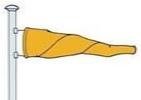Safety on the beach
Please note: We have closed the Alinora slipway (at the Marine Crescent car park, between Seafield Avenue and Alinora Crescent in Worthing) as it is unsafe for launching watercraft.
See also:
Beach safety flags

Red flag
- The red flag indicates danger.
- Never enter the water when the red flag is flying, under any circumstances.

Orange windsock
- The orange windsock indicates offshore wind conditions.
- You should never use an inflatable when the sock is flying.
Stay safe stay alive
On the beach:
- Always swim parallel to (along) the shore
- Do not swim just after a meal
- Do not swim or play on or near groynes, rocks or breakwaters
- Children near water should always be supervised
- Be careful of potholes on sandy beaches covered by the sea
- Do not panic if in difficulty in the sea. Lie on your back, keep still, raise one arm and shout. Most of us float naturally if we keep still - try to look up as you lie
When in, or near water:
- Go with a friend if possible
- Tell someone where you are going and when you will be back
- Read and obey notices and never cover them
- Report missing lifesaving equipment (and anyone taking it or breaking it)
- Do not leave litter on the beach - glass and opened cans are very dangerous
- Do not touch strange objects, tell the coastguard or police about them
- Do not go out on air beds or other inflatables unless it is tethered to the shoreline and watched by an adult.
Going sailing:
- Check weather conditions with the coastguard/weather centre and listen to the weather forecast.
- 'Sign On' with the Coastguard Yacht and Boat Safety Scheme - information from any Coastguard Station.
Board sailing:
- Never try to teach yourself.
- Wear a wetsuit.
- Do not go out too far and be considerate of other water users.
- Keep your rig in good condition and do not leave it unattended.
- Never leave your board and attempt to swim ashore
Guidance for swimming safely in the sea
Always be prepared ...
Check the weather and tides
It is important to be aware of the conditions before you go out swimming. Even in the summer months, the water in the sea can still be rather cold. You may choose to discuss sea swimming with your GP.
The direction and speed of the wind can affect the conditions of the sea, making the waves too choppy and dangerous for most.
Take note of the tide times for when you are going swimming, you may not want the water to be too far out! Likewise, it isn’t always the safest time to swim on high tide. The shape of our beach can create quite a shore dump, which means for high tides the water may roll and dump on the shore, making it difficult to enter and exit the water. You don’t want to get yourself or anyone else in difficulty. Often 2 to 3 hours before or after high tide is safer.
Choose your spot
Think carefully about where you are going to swim. Is the area free from obstruction? Can you enter and exit the water safely?
Swim with a buddy
It is much safer to swim with a partner or a group of friends. People look out for each other when they are in the water, it is also good for a chat too!
Have the right equipment
You want to be seen and warm when you are in the water. Wear a bright coloured hat and a tow float so you can be seen by other water users. You might like to wear some neoprene gloves, shoes or socks to help protect your hands and feet from the cold water. Swimming in a wetsuit will help you stay warm and can increase your buoyancy. Ensure you quickly change into warm clothes when you come out of the sea and enjoy a flask of something warm to sip to warm up safely.
Swimming in the sea
Whatever time of year, the sea is cold. Go in slowly to acclimatise yourself. Breathe calmly and splash water on your hands, face and neck to get used to the cold.
When you swim in the sea swim between the groynes, rather than going out into deeper water. If you are new to sea swimming it is definitely a good idea to keep yourself in shallow water so you can stand. Don’t forget to swim with a buddy!
Swimming in cold water is tiring and you may not be able to last as long as you do in a pool. Be mindful of this and always leave wanting more rather than staying in too long. If you do need to rest, lie on your back and float, until you have the energy to swim back to the beach.
In an emergency, call 999 or 112 and ask for the Coastguard.
Is the water safe?
On a daily basis from 1st May - 30th September, the Coastal Office is contacted by the Environment Agency to notify if there is a chance of reduced water quality. Signs will be changed to show this in Worthing and Lancing.
You can access water quality updates, see:
Southern Water also provides near real-time information about storm release activity near coastal bathing waters, see:
Tombstoning: what is it, and what are the dangers?
Tombstoning is the act of jumping into the sea from a high platform, like the pier or rock groynes. It can be extremely dangerous, it can cause life changing injuries or even death.
One of Worthing Borough Council's byelaws for Worthing Pier is:
6. (i) No person shall without reasonable excuse, bathe, dive, jump or attempt to bathe, dive or jump in the sea from the Pier
(ii) No person bathing in the sea shall without reasonable excuse land or attempt to land or climb upon the Pier.
Coastal Wardens from Worthing Coastal Office regularly patrol the pier and contact the police every time there is tombstoning from Worthing Pier. The byelaw also states that you could be charged a fine of £50 for jumping off the pier.
Keep yourselves and your friends safe by not jumping off Worthing Pier or any rock groynes.
The message is clear, don't do it! Don't let alcohol, drugs or peer pressure affect your judgement. Even if you think you are jumping safely, children may be watching and copy your actions.
As a seaside community we should all be aware that water depth alters with the tide; the water may be shallower than it seems, in addition submerged objects like rocks may not be visible; the shock of cold water may make it difficult to swim, and strong currents can rapidly sweep people away.
Even during fine weather the risks associated with the sea are ever present, this includes pier jumping and playing on or jumping from the rock groynes.
For more information about tombstoning (jumping or diving from a height into water), see:

Need assistance with this service?
Get in touch:
Coastal Office
Problem with this page?
Page last updated: 01 July 2025

